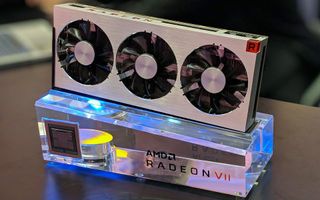Hands on with the AMD Radeon VII
Additional details on specs, and a chance to play The Division 2.

AMD revealed its Radeon VII during today's CES keynote, and shortly after we met with the company to get a few more details on the hardware. As you'd expect, AMD isn't spilling the beans on everything yet, including performance, but we did get confirmation of a few specs. Here's what we know.
First, the base clockspeed for the GPU is 1450MHz, with a current target of 1750MHz for the boost clock. The 1.8GHz figure AMD showed in its slides is a 'peak clock', which may or may not be achievable on all parts. As for the TDP, AMD is going with 300W for the Radeon VII, 5W higher than the Vega 64 but basically the same. Regarding architectural changes, AMD says Vega 7nm is mostly the same as the previous Vega, with just some small tweaks. Obviously one of the biggest differences is that Vega 7nm now supports four stacks of HBM2, compared to two stacks on the previous iteration.
With only one model discussed during the keynote, we of course wanted to know if others are in the works. Vega 64, for instance, has 4,096 cores compared to 3,840 cores on the Radeon VII, which suggests there may be four disabled CUs right now. That leaves a bit of room for a higher performance option, and we know the Radeon Instinct MI60 includes 64 CUs and 4,096 cores as well (and twice as much HBM2 at 32GB), but AMD isn't saying anything yet.

The same goes for a lower spec model. The Radeon Instinct MI50 already has similar specs to the announced Radeon VII consumer card. AMD can certainly do a lower tier card, and we may yet see that, but mum's the word for now. There are a few options that might work, including four 2GB HBM2 stacks, or three 4GB HBM2 stacks with one stack disabled, along with lower clockspeeds and fewer CUs. But we'll have to wait and see.
Given AMD has already announced an availability date of February 7, it's no surprise that we were able to spend a short amount of time with working hardware. AMD let us play a pre-release version of The Division 2 running on Radeon VII, and it chugged along nicely—though we weren't able to run any performance tests or check the settings. We know it was running at 4k and it felt smooth, but that's about all we can say.
We're looking forward to doing our usual full suite of benchmarks in the near future, and hope we'll be welcoming the VII to our list of the best graphics cards too, so stay tuned.

The biggest gaming news, reviews and hardware deals
Keep up to date with the most important stories and the best deals, as picked by the PC Gamer team.
Jarred's love of computers dates back to the dark ages when his dad brought home a DOS 2.3 PC and he left his C-64 behind. He eventually built his first custom PC in 1990 with a 286 12MHz, only to discover it was already woefully outdated when Wing Commander was released a few months later. He holds a BS in Computer Science from Brigham Young University and has been working as a tech journalist since 2004, writing for AnandTech, Maximum PC, and PC Gamer. From the first S3 Virge '3D decelerators' to today's GPUs, Jarred keeps up with all the latest graphics trends and is the one to ask about game performance.
Most Popular





